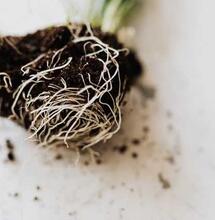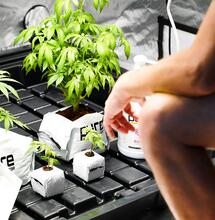Meters Part 2

Meters 2 allow gardeners to measure specific elements so each can be incrementally improved.
Electric and Light Meters
Light meters measure light intensity and spectrum. Inexpensive to moderately priced meters measure light in foot-candles, lux, and lumens. These scales measure light that is visible to humans—400 to 700 nm (nanometers). But, plants do not use the entire light spectrum equally, and light sources do not generate spectrums equally. While our eyes may see only the blending of the light frequencies, plants are looking for specific wavelengths to trigger responses in the various photosystems.
PAR (photosynthetically active radiation) light is the spectrum fingerprint plants need to see, and anything else, while we may see it as very bright, the plant does not see or use. Matching lamp spectrum to the PAR requirements of the plant is important. [caption id="attachment_9018" align="alignnone" width="800"] Light meter[/caption] You can use a light meter that measures foot-candles, lux, or lumens to measure the intensity of sunlight, HP sodium, metal halide, CFL, and fluorescent light. Sunlight is generally perfect for cannabis growth, and there is little we can do to change it. Light intensity meters that measure foot-candles, lux, and lumens are accurate when measuring the intensity of lamps with known PAR ratings.
Indoors, always use lamps with the highest PAR rating. PAR or quantum light meters often claim to accurately measure the photons or light particles that plants need to grow. Meters often measure lux and then convert to PAR. High-quality sophisticated quantum meters can switch to measure “sunlight” or “electric lamps.” Quantum light meters display a specific numeric PAR value in the LED screen. A PAR meter is not necessary to measure natural sunlight.
Soil, Nutrient-Solution and Water Meters
pH meters measure the potential hydrogen (pH) in a substance or solution. Measurement and control of pH are essential to healthy medical cannabis gardens. [caption id="attachment_9020" align="alignnone" width="800"] Potential Hydrogen (pH) meter[/caption] Digital meters measure electrical current between two probes and are designed to work in water and moist soil. The growing medium must be moist for an accurate reading. Digital electronic meters can make thousands of measurements with little or no additional cost per test. Electronic pH meters are economical and convenient.
Less expensive pH meters lack automatic temperature compensation but are accurate enough for casual use. Intermediately priced digital pH meters contain a glass bulb electrode that must be kept clean and moist at all times. Proper maintenance ensures accurate readings. Digital pH meters—when properly maintained and calibrated—can accurately perform hundreds of tests. More expensive models are quite accurate when properly calibrated. These meters must be regularly calibrated to ensure their accuracy. The inexpensive probe meters are not very accurate, and the intermediately priced meters also have accuracy issues.
Pay special attention to soil moisture when taking a pH test with an electronic meter. The meters measure the electrical current between two probes and are designed to work in moist soil. If the soil is dry, the probes do not give an accurate reading. More-expensive models contain a glass bulb electrode that must be kept clean and moist at all times. Failure to maintain the tester properly could lead to inaccurate readings. An automatic temperature compensation (ATC) feature makes meters much more convenient and accurate.
Nutrient (Ionic Salt) Meters
EC = electrical conductivity ppm = parts per million CF = conductivity factor TDS = total dissolved solids Different measurement systems all use the same base, but they interpret the information differently. Let’s start with electrical conductivity (EC), the most accurate and consistent scale. EC is measured in millisiemens per centimeter (mS/cm) or microsiemens per centimeter (μS/cm). One millisiemen per centimeter = 1,000 microsiemens per centimeter.* EC is the most accurate measure of total ionic salts in solution. An EC meter measures the overall volume or strength of elements (ionic salts) in water or solution. *millimhos and micromhos are other units of measurement often used for plant recommendations. 1 millisiemens = 1 millimhos = 1,000 microsiemens = 1,000 millimhos Parts per million (ppm) meters actually measure in EC and convert to ppm.
Unfortunately, the two scales (EC and ppm) are not directly related. Each nutrient or salt gives a different electronic discharge reading. To overcome this obstacle, an arbitrary standard assumes that “a specific EC equates to a specific amount of nutrient solution.” Consequently, the ppm reading is only an approximation. Also, manufacturers of nutrient testers use different standards to convert from EC to the ppm reading. Every salt in a multielement solution has a different conductivity factor (CF).
Pure water will not conduct electrical current, but when elemental salts/metals are added, electrical conductivity increases proportionately. Simple electronic meters measure this value and interpret it as total dissolved solids (TDS). Nutrient solutions used to grow cannabis generally range between 500 and 2,000 ppm. If the solution concentration is too high, the internal osmotic systems can reverse and actually dehydrate the plant. In general, try to maintain a moderate value of approximately 800 to 1,200 ppm. The EC should stay below a high of 2.7.
Electrical conductivity (EC) meters
measure the overall volume or strength of elements in water or solution. A digital LCD screen displays a reading of electrical current flowing between the two electrodes. Pure rainwater has an EC close to zero. Check the pH and EC of rainwater to find out if it is acidic (acid rain) before using it. [caption id="attachment_9017" align="alignnone" width="800"] Electrical Conductivity (EC) meter[/caption] Distilled bottled water from the grocery store often registers a small amount of electrical resistance, because it is not perfectly pure. Pure water with no resistance is very difficult to obtain and is not necessary for a hydroponic nutrient solution. Electrical conductivity measurement is temperature-sensitive and must be factored into EC readings to retain accuracy.
High-quality meters have automatic and manual temperature adjustments. Calibrating an EC meter is similar to calibrating a pH meter. Simply follow manufacturer’s instructions. For an accurate reading, make sure your nutrient solution and stock solution are at the same temperature. Inexpensive meters last for about a year; expensive meters can last for many years. However, the life of most EC meters, regardless of cost, is contingent upon regular maintenance. The meter’s probes must be kept moist and clean at all times. This is the most important part of keeping the meter in good repair.
Read instructions on care and maintenance. Watch for corrosion buildup on the probes of your meter. When the probes are corroded, readings will not be accurate. Digital dissolved salt meters are used to measure the overall strength of a nutrient solution. Nutrient (ionic salt) concentrations are measured by their ability to conduct electricity through a solution. Several scales are currently used to measure how much electricity is conducted by the concentration of ionic salts (nutrients) between two electrodes. A digital LCD screen displays the reading in one of the following scales: CF, DS, EC, ppm or TDS, which all measure the same thing: dissolved ionic (fertilizer) salts. Each meter has a different scale but more sophisticated meters are able to make readouts in several scales including CF, EC, ppm, and TDS.
Most North American gardeners use the ppm scale to measure overall fertilizer concentration. European, Australian, and New Zealand gardeners use EC, however they still use CF in parts of Australia and New Zealand. Parts per million is not as accurate or consistent as EC to measure nutrient solution strength. The difference between CF, EC, ppm, TDS, and DS is more complex than originally meets the eye. Different measurement systems all use the same base, millisiemens per centimeter, but they interpret the information differently. A dissolved solids (DS) measurement indicates how many parts per million of dissolved solids exist in a solution. A reading of 1,800 ppm means there are 1,800 parts of nutrient in one million parts of solution, or 1,800/1,000,000. Make sure to calibrate your meter before using it. [caption id="attachment_9021" align="alignnone" width="800"] Total Dissolved Solids (TDS) meter[/caption]
A total dissolved solids (TDS) meter
measures solution EC and uses an approximate conversion scale to convert to ppm. The conversion is not very accurate because solutions that are composed of different elements will have different ppm values. One conversion figure becomes exceedingly inaccurate. The most accurate measure is osmotic concentration (or EC) because this is what the root systems respond to in a nutrient solution. Parts per million meters measure the overall level of dissolved solids or fertilizer salts.
Each fertilizer salt conducts different quantities of electricity. Use a calibrating solution that imitates the fertilizer in the nutrient solution to calibrate ppm or EC meters. Using such a solution ensures that the meter readings will be as accurate as possible. For example, 90 percent of ammonium nitrate dissolved in water is measured, and a mere 40 percent of magnesium is measured! Do not use sodium-based calibration solutions. They are intended for other applications than gardening. Purchase calibrating solution from the manufacturer or retailer when you buy the meter. Ask for a stable calibrating solution that mimics your fertilizer. Calibrate EC and ppm meters regularly.
This is the second part of an excerpt from chapter 15, “Meters” from the Cannabis Encyclopedia (596 pages, 2,000+ color images, large A4 format) by Jorge Cervantes, available on amazon. For more information please see Jorge´s website, www.marijuanagrowing.com.
.png)


